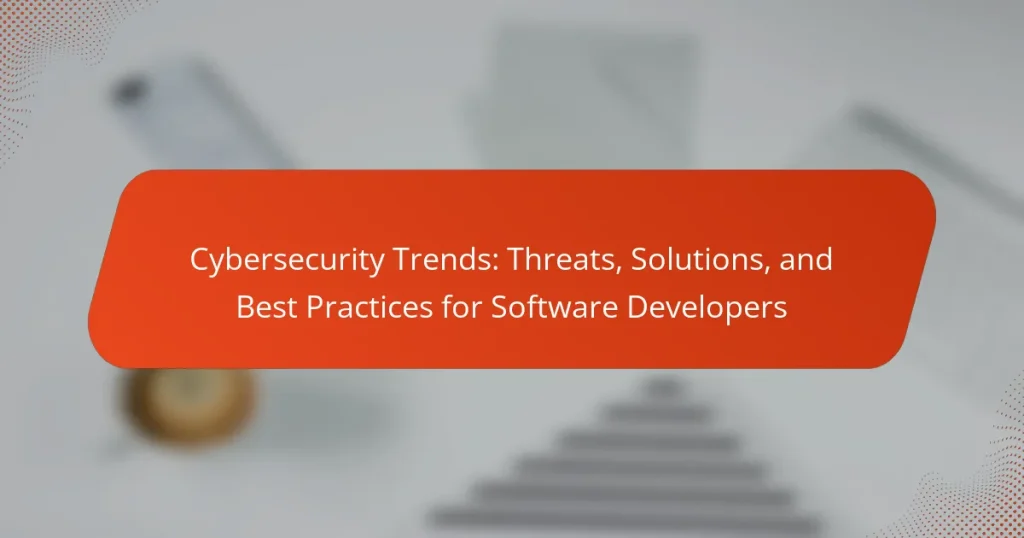Cybersecurity trends significantly impact software developers, emphasizing the integration of security throughout the software development lifecycle (SDLC). Key trends include the adoption of DevSecOps, which incorporates security as a shared responsibility, and the necessity for secure coding practices to combat increasing cyber threats. The reliance on third-party libraries presents additional vulnerabilities, making it crucial for developers to manage these dependencies effectively. With the rise of artificial intelligence in cybersecurity and the implementation of zero-trust security models, developers must enhance their threat detection capabilities and ensure robust authentication mechanisms. Continuous education on evolving cybersecurity regulations and threats is essential for maintaining application integrity and protecting against data breaches.

What are the current cybersecurity trends impacting software developers?
Current cybersecurity trends impacting software developers include the rise of DevSecOps, increased focus on secure coding practices, and the prevalence of third-party library vulnerabilities. DevSecOps integrates security into the development process, ensuring that security is a shared responsibility. This trend is driven by the need for faster deployment cycles without compromising security.
Secure coding practices are becoming essential as developers face growing threats from sophisticated cyber attacks. According to the 2022 Verizon Data Breach Investigations Report, 82% of data breaches involve a human element, highlighting the importance of training developers on secure coding techniques.
Furthermore, the use of third-party libraries is common in software development, but these can introduce vulnerabilities. Research from the GitHub Octoverse report indicates that 70% of codebases rely on open-source libraries, making it critical for developers to monitor and manage these dependencies effectively.
Overall, these trends emphasize the need for developers to adopt a proactive security mindset throughout the software development lifecycle.
How are emerging threats evolving in the cybersecurity landscape?
Emerging threats in the cybersecurity landscape are evolving through increased sophistication and targeted attacks. Cybercriminals are leveraging advanced technologies like artificial intelligence and machine learning. These technologies enable more effective phishing schemes and automated attacks. Additionally, the rise of the Internet of Things (IoT) expands the attack surface. Vulnerabilities in connected devices are increasingly exploited by attackers. Ransomware attacks have also become more prevalent, often targeting critical infrastructure. According to the Cybersecurity & Infrastructure Security Agency (CISA), ransomware incidents surged by 300% in 2020. This evolution necessitates adaptive security measures and continuous monitoring by organizations.
What types of cyber threats are most prevalent today?
The most prevalent types of cyber threats today include ransomware, phishing, malware, and distributed denial-of-service (DDoS) attacks. Ransomware encrypts data and demands payment for decryption. Phishing exploits social engineering to steal sensitive information. Malware encompasses various malicious software designed to harm or exploit devices. DDoS attacks overwhelm services with traffic, causing disruptions. According to Cybersecurity Ventures, ransomware damage costs are projected to reach $265 billion by 2031. The FBI reported that phishing attacks increased by 110% in 2020. These statistics underscore the serious nature and growing prevalence of these cyber threats.
How do these threats specifically target software development practices?
Threats specifically target software development practices by exploiting vulnerabilities in code and processes. Cyber attackers often use techniques like code injection, which allows them to manipulate software behavior. They may also leverage insecure APIs to gain unauthorized access to systems. Additionally, threats can arise from third-party libraries that contain malicious code. These practices compromise the integrity and security of software products. According to the 2021 Verizon Data Breach Investigations Report, 22% of breaches involved web applications, highlighting the risk in development practices. Furthermore, the OWASP Top Ten lists common vulnerabilities, emphasizing that developers must address these threats during the software lifecycle.
What solutions are available to counteract these cybersecurity threats?
Implementing multi-factor authentication is a key solution to counteract cybersecurity threats. This method requires users to provide two or more verification factors to gain access. Regular software updates help close vulnerabilities that cybercriminals exploit. Firewalls serve as a barrier between trusted internal networks and untrusted external networks. Intrusion detection systems monitor network traffic for suspicious activity. Employee training on cybersecurity best practices reduces the risk of human error. Data encryption protects sensitive information from unauthorized access. Regular security audits identify weaknesses in a system’s defenses. These solutions collectively enhance an organization’s cybersecurity posture.
How effective are current cybersecurity tools and technologies?
Current cybersecurity tools and technologies are generally effective but face challenges. They provide robust protection against known threats. However, they often struggle with emerging and sophisticated attacks. A report from Cybersecurity Ventures predicts cybercrime damages will reach $10.5 trillion annually by 2025. This indicates a growing gap in effectiveness. Furthermore, a 2023 study by the Ponemon Institute found that 60% of organizations reported experiencing a data breach despite using cybersecurity tools. This highlights that while tools are essential, they are not foolproof. Continuous updates and training are necessary to enhance their effectiveness.
What role do software developers play in implementing these solutions?
Software developers play a critical role in implementing cybersecurity solutions. They design and build secure software applications. Developers integrate security features during the development process. They conduct code reviews to identify vulnerabilities. Developers also implement security testing to ensure robustness. They stay updated on cybersecurity trends and threats. This knowledge helps them create resilient systems. By following best practices, developers enhance overall security posture.
What best practices should software developers follow to enhance cybersecurity?
Software developers should follow several best practices to enhance cybersecurity. First, they must implement secure coding practices. This includes validating input to prevent injection attacks. Developers should also apply the principle of least privilege. Each user should have only the access necessary for their role. Regular code reviews and security testing are essential. These practices help identify vulnerabilities early. Additionally, developers should keep software dependencies updated. Outdated libraries can expose applications to known vulnerabilities. Using encryption for sensitive data is crucial. This protects data both in transit and at rest. Training and awareness about security threats are also important. Developers should be informed about the latest cybersecurity trends and threats. By adhering to these practices, developers can significantly reduce the risk of security breaches.
How can developers integrate security into the software development lifecycle?
Developers can integrate security into the software development lifecycle (SDLC) by adopting security practices at every phase. This includes conducting threat modeling during the planning phase. Developers should also implement secure coding standards during the development phase. Regular code reviews and static analysis tools help identify vulnerabilities early.
In the testing phase, dynamic application security testing (DAST) can uncover runtime issues. Additionally, incorporating security training for developers enhances awareness of potential risks. Finally, during deployment and maintenance, continuous monitoring and patch management are essential to address emerging threats. These practices ensure that security is a fundamental aspect of the SDLC rather than an afterthought.
What training and resources are available for developers to improve their cybersecurity skills?
Developers can improve their cybersecurity skills through various training programs and resources. Online platforms like Coursera and Udemy offer courses focused on cybersecurity fundamentals and advanced topics. Additionally, organizations such as the SANS Institute provide intensive training sessions and certifications. The Offensive Security Certified Professional (OSCP) certification is highly regarded in the industry.
Books like “The Web Application Hacker’s Handbook” offer in-depth knowledge on security practices. Participating in Capture The Flag (CTF) competitions helps developers practice skills in real-world scenarios. Furthermore, engaging with communities such as OWASP provides access to valuable tools and knowledge-sharing opportunities.
These resources collectively enhance developers’ understanding of cybersecurity threats and best practices.

What are the implications of cybersecurity threats for software development?
Cybersecurity threats significantly impact software development by introducing risks that can compromise application integrity. Developers must prioritize security throughout the software development life cycle (SDLC). This includes integrating security measures from the initial design phase. Regular security testing is essential to identify vulnerabilities early. Failure to address these threats can lead to data breaches, resulting in financial losses and reputational damage. According to a report by IBM, the average cost of a data breach in 2021 was $4.24 million. Additionally, software that lacks robust security features can face regulatory penalties. Thus, cybersecurity threats necessitate a proactive approach to secure coding practices and ongoing education for developers.
How do cybersecurity threats affect software quality and performance?
Cybersecurity threats negatively impact software quality and performance. These threats can lead to vulnerabilities that compromise functionality. For instance, a software product may experience increased downtime due to attacks. This downtime affects user experience and can reduce overall satisfaction. Additionally, security breaches can result in data loss, which can degrade software integrity. Performance can also suffer due to the implementation of additional security measures. These measures may slow down system processes. Research indicates that 60% of small businesses close within six months of a cyber attack, highlighting the critical need for robust cybersecurity. Therefore, addressing cybersecurity threats is essential for maintaining software quality and performance.
What risks do vulnerabilities pose to end-users and organizations?
Vulnerabilities pose significant risks to end-users and organizations. They can lead to unauthorized access to sensitive data. This may result in data breaches, exposing personal and financial information. Cybercriminals often exploit these vulnerabilities for malicious purposes. Organizations can suffer financial losses due to remediation costs and legal penalties. A report by IBM noted that the average cost of a data breach in 2021 was $4.24 million. Additionally, vulnerabilities can damage an organization’s reputation and customer trust. End-users may face identity theft and fraud as a direct consequence. Overall, the impact of vulnerabilities can be extensive and detrimental.
How can security breaches impact a company’s reputation?
Security breaches can severely damage a company’s reputation. Customers often lose trust in a brand after a breach. A study by IBM found that 75% of consumers would not do business with a company that experienced a data breach. Negative media coverage can amplify this loss of trust. Competitors may capitalize on the breach to attract customers. Recovery from reputational damage can take years. Businesses may face increased scrutiny from regulators following a breach. Long-term financial impacts can result from lost customers and legal costs.
What regulatory requirements should software developers be aware of?
Software developers should be aware of various regulatory requirements related to data protection and cybersecurity. Key regulations include the General Data Protection Regulation (GDPR) in the European Union, which mandates strict data handling practices. Developers must also consider the Health Insurance Portability and Accountability Act (HIPAA) for software handling health information in the U.S. Additionally, the Payment Card Industry Data Security Standard (PCI DSS) is crucial for applications processing credit card transactions. Compliance with these regulations is essential to avoid legal penalties and ensure user trust. Each regulation outlines specific guidelines for data encryption, user consent, and breach notification. Understanding these requirements helps developers create secure and compliant software solutions.
How do compliance standards influence software development practices?
Compliance standards significantly influence software development practices by enforcing specific security and quality requirements. These standards guide developers in creating software that meets legal and regulatory obligations. For instance, standards like ISO/IEC 27001 mandate risk management and security controls. Adhering to these standards helps organizations avoid legal penalties and reputational damage. Additionally, compliance can drive the adoption of best practices in coding, testing, and documentation. This often leads to improved software quality and security posture. Organizations that align with compliance standards may also gain a competitive advantage in the market.
What are the consequences of failing to meet cybersecurity regulations?
Failing to meet cybersecurity regulations can lead to significant financial penalties. Organizations may face fines that can reach millions of dollars. Non-compliance can also result in legal liabilities, including lawsuits from affected parties. Additionally, businesses may suffer reputational damage, leading to loss of customer trust. This can impact sales and market position. Furthermore, regulatory bodies may impose increased scrutiny and audits on non-compliant organizations. In some cases, failure to comply can lead to operational restrictions or shutdowns. According to a 2020 report by the Ponemon Institute, the average cost of non-compliance can exceed $14 million.

What future trends should software developers anticipate in cybersecurity?
Software developers should anticipate increasing integration of artificial intelligence in cybersecurity. AI will enhance threat detection and response capabilities. Machine learning algorithms can analyze vast amounts of data for anomalies. This allows for quicker identification of potential threats. Additionally, the rise of zero-trust security models will become more prevalent. Zero-trust emphasizes verifying every user and device attempting to access resources. Developers will need to implement robust authentication mechanisms. The demand for secure software development practices will also grow. This includes adopting DevSecOps methodologies to incorporate security at every development stage. Furthermore, regulatory compliance will tighten, requiring developers to stay updated on laws. The growing sophistication of cyberattacks will necessitate continuous learning and adaptation.
How will AI and machine learning shape the future of cybersecurity?
AI and machine learning will significantly enhance cybersecurity by improving threat detection and response times. These technologies can analyze vast amounts of data quickly. They identify patterns indicative of cyber threats. For example, machine learning algorithms can detect anomalies in network traffic. This capability allows for real-time alerts to potential breaches. AI can also automate responses to common threats, reducing the workload on cybersecurity teams. According to a report by Cybersecurity Ventures, AI-driven security solutions are expected to reduce response times by up to 90%. This efficiency is crucial as cyberattacks become more sophisticated and frequent.
What advancements are expected in threat detection and response?
Advancements in threat detection and response include the integration of artificial intelligence and machine learning. These technologies enhance the ability to analyze vast amounts of data quickly. AI can identify patterns and anomalies that indicate potential threats. Machine learning algorithms continuously improve by learning from new data. Automated response systems are also expected to evolve, enabling real-time threat mitigation. This reduces the time it takes to respond to incidents significantly. Additionally, improved threat intelligence sharing among organizations will facilitate better preparedness. Enhanced collaboration will lead to a more proactive cybersecurity posture. Research indicates that organizations adopting these advancements will experience reduced breach costs and improved incident response times.
How might the role of software developers evolve in response to these changes?
The role of software developers will evolve to prioritize cybersecurity skills. As cyber threats increase, developers must integrate security practices into the software development lifecycle. This shift will require a deeper understanding of secure coding techniques. Developers will need to collaborate closely with cybersecurity teams. They will also be responsible for conducting regular security assessments. Additionally, continuous education on emerging threats will become essential. According to a report by the World Economic Forum, 95% of cybersecurity breaches are due to human error. This statistic underscores the need for developers to be proactive in security measures.
What proactive measures can developers take to stay ahead of cybersecurity threats?
Developers can stay ahead of cybersecurity threats by implementing secure coding practices. This includes validating user inputs to prevent injection attacks. Regularly updating software dependencies reduces vulnerabilities. Conducting security audits and code reviews identifies potential weaknesses early. Utilizing automated security testing tools can catch issues before deployment. Educating teams on cybersecurity awareness fosters a security-first culture. Following industry standards, such as OWASP guidelines, enhances security measures. These proactive strategies collectively strengthen software resilience against cyber threats.
How can continuous learning and adaptation enhance a developer’s cybersecurity posture?
Continuous learning and adaptation enhance a developer’s cybersecurity posture by keeping them informed about evolving threats. Developers who engage in ongoing education can identify vulnerabilities more effectively. They become familiar with the latest security tools and practices. This knowledge helps them implement stronger security measures in their code. Regular updates on cybersecurity trends allow developers to anticipate potential attacks. Studies show that organizations with trained developers experience fewer security breaches. A proactive approach to learning fosters a culture of security awareness. This ultimately leads to more robust software and safer user experiences.
What are some practical tips for software developers to implement effective cybersecurity measures?
Software developers can implement effective cybersecurity measures by following best practices. First, they should adopt secure coding practices. This includes validating input and sanitizing data to prevent injection attacks. Second, they must regularly update dependencies and libraries. Using outdated software can introduce vulnerabilities. Third, developers should implement proper authentication mechanisms. Strong passwords and multi-factor authentication enhance security. Fourth, they need to conduct regular security testing. Tools like static analysis and [censured] testing can identify weaknesses. Fifth, developers should educate themselves on cybersecurity trends. Awareness of current threats helps in proactive defense. Lastly, maintaining comprehensive logging and monitoring is crucial. This allows for quick detection of suspicious activities. These practices collectively strengthen the overall security posture of software applications.
The main entity of the article is cybersecurity trends relevant to software developers. The article examines current trends affecting software development, including the rise of DevSecOps, secure coding practices, and vulnerabilities associated with third-party libraries. It also discusses the evolution of emerging threats such as ransomware and phishing, and highlights prevalent cyber threats targeting development practices. Furthermore, the article outlines effective solutions and best practices for developers to enhance cybersecurity, the implications of these threats on software quality, and the importance of compliance with regulatory standards. Lastly, it emphasizes the evolving role of developers in integrating security measures throughout the software development lifecycle.




